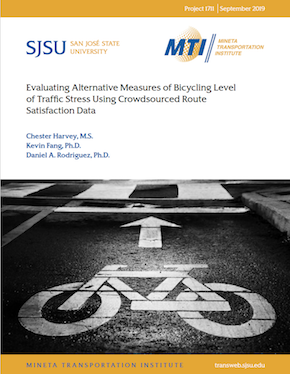- 408-924-7560
- mineta-institute@sjsu.edu
- Donate
Evaluating Alternative Measures of Bicycling Level of Traffic Stress Using Crowdsourced Route Satisfaction Data
Approaches for evaluating the quality of bicycling have become increasingly important for planning bicycle infrastructure improvements. Mekuria, Furth, and Nixon’s (2012) “Level of Traffic Stress” (LTS) approach, which requires minimal data inputs and produces a simple and intuitive output, has emerged as a widely-used framework for identifying streets that are “low-stress” for cyclists. The LTS framework is based on a hierarchy of characteristics, largely related to traffic speed and roadway layout, that are presumed to cause higher or lower levels of stress. Despite the apparent simplicity of LTS, several key challenges emerge from its application. Firstly, multiple LTS classification methods have been developed, and it is difficult to know whether they represent stress in equivalent ways. Secondly, LTS is intended only to define an ordinal scale of stressfulness, but has often been misinterpreted as defining a continuous scale; there is no intended implication that the stress levels are spaced equally. Third, while LTS provides a useful summary of diverse infrastructural variables, it is poorly understood which of these variables are most strongly associated with cyclist satisfaction and may, therefore, be most important to capture in an LTS framework.
These challenges were examined in the contexts of two U.S. cities: Portland, Oregon, which has a very well-developed bicycling infrastructure, and Austin, Texas, which has more moderately-developed bicycling infrastructure. In both cities, LTS outcomes differed depending on the LTS classification method used. In addition, even when classified using the same method, LTS outcomes differed depending on the source of the data used. This suggests that LTS analyses based on different methods or data sources are unlikely to be comparable. Associations between LTS classifications and continuously-scaled user satisfaction data from the crowdsourcing mobile app Ride Report suggested that LTS levels represented a fairly linear scale, though differences in average Ride Report scores between successive LTS levels were rarely large. Ride Report user satisfaction data were most strongly and consistently associated with variables related to bicycling-specific infrastructure, such as bike lanes and boulevards, and indicators of street size. These variables may be most useful for developing LTS classification methods with minimal data inputs. Unsurprisingly, our analysis also supports the addition of bicycle-specific infrastructure and reduction of roadway size and traffic volume as among the most effective approaches for reducing LTS levels and maximizing user satisfaction along cycling networks.
CHESTER HARVEY, MS
Chester Harvey is a PhD candidate at the University of California, Berkeley. His research examines intersections between transportation and urban design, with a particular focus on how microscale elements of streets and their built contexts influence the psychology and behavior of users. He also develops computational methods for examining the forms of urban environments. Chester is also a practicing Planner and Data Scientist at Alta Planning + Design.
KEVIN FANG, PhD
Kevin Fang is Assistant Professor of Geography, Environment, and Planning at Sonoma State University. His research centers on the characteristics of sustainable alternative modes of transportation and their users, with a particular focus on emerging “micromobility” travel modes. He also works in the areas of transportation impact analysis in environmental review.
DANIEL A. RODRIGUEZ, PhD
Daniel A. Rodriguez is Chancellor’s Professor in the Department of City and Regional Planning and Associate Director of the Institute for Transportation Studies at The University of California, Berkeley. His research focuses on the reciprocal relationship between the built environment and transportation, and its effects on the environment and health.
-
Contact Us
San José State University One Washington Square, San Jose, CA 95192 Phone: 408-924-7560 Email: mineta-institute@sjsu.edu






